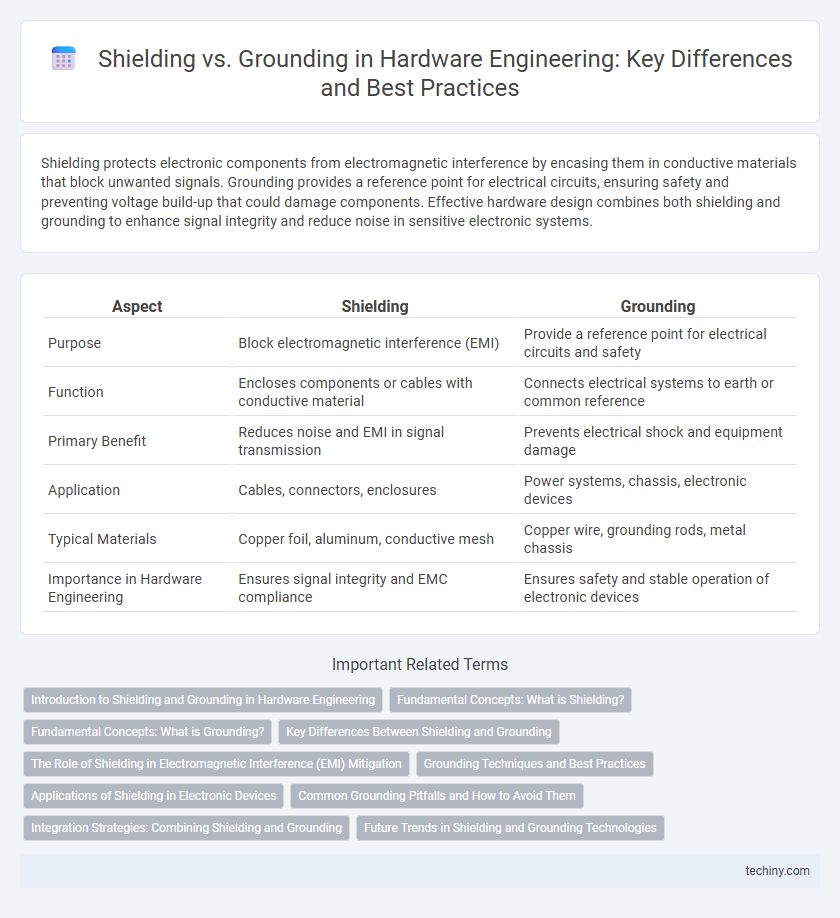Shielding protects electronic components from electromagnetic interference by encasing them in conductive materials that block unwanted signals. Grounding provides a reference point for electrical circuits, ensuring safety and preventing voltage build-up that could damage components. Effective hardware design combines both shielding and grounding to enhance signal integrity and reduce noise in sensitive electronic systems.
Table of Comparison
| Aspect | Shielding | Grounding |
|---|---|---|
| Purpose | Block electromagnetic interference (EMI) | Provide a reference point for electrical circuits and safety |
| Function | Encloses components or cables with conductive material | Connects electrical systems to earth or common reference |
| Primary Benefit | Reduces noise and EMI in signal transmission | Prevents electrical shock and equipment damage |
| Application | Cables, connectors, enclosures | Power systems, chassis, electronic devices |
| Typical Materials | Copper foil, aluminum, conductive mesh | Copper wire, grounding rods, metal chassis |
| Importance in Hardware Engineering | Ensures signal integrity and EMC compliance | Ensures safety and stable operation of electronic devices |
Introduction to Shielding and Grounding in Hardware Engineering
Shielding in hardware engineering involves the use of conductive or magnetic materials to block electromagnetic interference (EMI) and prevent signal degradation in electronic circuits. Grounding establishes a common reference point for electrical potentials, ensuring safety and reducing noise by providing a low-resistance path for fault currents and static charge dissipation. Effective hardware design integrates both shielding and grounding techniques to enhance signal integrity and protect sensitive components from EMI.
Fundamental Concepts: What is Shielding?
Shielding in hardware engineering involves enclosing electronic components or cables with conductive materials to block electromagnetic interference (EMI) and radio frequency interference (RFI). This barrier prevents external noise from disrupting signal integrity and reduces emissions of electromagnetic noise from sensitive devices. Effective shielding uses materials like copper, aluminum, or conductive polymers to create a protective layer that maintains system performance and reliability.
Fundamental Concepts: What is Grounding?
Grounding in hardware engineering refers to creating a common reference point in an electrical circuit, typically connected to the earth, to ensure safety and proper operation by stabilizing voltage levels and preventing electrical shock. It provides a path for fault currents to flow safely into the ground, reducing the risk of damage to components and minimizing electromagnetic interference. Effective grounding is essential for maintaining signal integrity and protecting sensitive electronic equipment from voltage spikes and static discharge.
Key Differences Between Shielding and Grounding
Shielding primarily involves enclosing electronic components with conductive materials to protect against electromagnetic interference (EMI), while grounding provides a reference point for electrical circuits to safely dissipate unwanted electric charges. Shielding reduces noise by blocking external electromagnetic fields, whereas grounding ensures safety and circuit stability by directing fault currents to the earth. Effective hardware design integrates both shielding and grounding to enhance signal integrity and minimize electromagnetic disturbances.
The Role of Shielding in Electromagnetic Interference (EMI) Mitigation
Shielding serves as a critical barrier that blocks electromagnetic interference (EMI) by enclosing sensitive electronic components, preventing electromagnetic fields from disrupting circuit performance. Unlike grounding, which provides a reference point to dissipate unwanted electrical noise, shielding physically contains and redirects EMI away from protected devices. Effective EMI mitigation integrates conductive materials such as copper or aluminum shields to absorb and reflect electromagnetic waves, ensuring signal integrity in high-frequency hardware engineering applications.
Grounding Techniques and Best Practices
Effective grounding techniques in hardware engineering ensure the safe dissipation of electrical currents and minimize electromagnetic interference (EMI). Best practices include using a dedicated ground plane, minimizing ground loops, and connecting all equipment to a common grounding point to maintain signal integrity and system reliability. Proper selection of grounding conductors and adherence to industry standards like IEEE 142 (Green Book) optimize overall electrical performance and safety.
Applications of Shielding in Electronic Devices
Shielding in electronic devices is crucial for minimizing electromagnetic interference (EMI) and radio frequency interference (RFI), ensuring signal integrity and reducing noise in sensitive circuits. It is widely applied in cables, connectors, printed circuit boards (PCBs), and enclosures to protect components from external electromagnetic fields and prevent data corruption. Common applications include medical devices, communication equipment, and consumer electronics where reliable performance and compliance with electromagnetic compatibility (EMC) standards are essential.
Common Grounding Pitfalls and How to Avoid Them
Common grounding pitfalls in hardware engineering include ground loops, improper ground connections, and inconsistent reference points that cause noise and signal integrity issues. Avoid these by implementing a single-point ground system, using star grounding techniques, and ensuring all components share a consistent and low-impedance ground reference. Proper PCB layout with dedicated ground planes and careful routing minimizes interference and enhances overall system stability.
Integration Strategies: Combining Shielding and Grounding
Integrating shielding and grounding in hardware engineering enhances electromagnetic interference (EMI) reduction by creating a comprehensive barrier against noise and ensuring proper current dissipation. Effective strategies involve bonding the shield to a low-impedance ground reference to minimize ground loops and optimize signal integrity. Combining these methods improves overall system robustness and compliance with EMC standards in complex electronic designs.
Future Trends in Shielding and Grounding Technologies
Emerging materials such as graphene and metamaterials are revolutionizing shielding effectiveness by offering superior electromagnetic interference (EMI) attenuation with reduced weight and thickness. Integration of smart grounding systems utilizing IoT sensors enables real-time diagnostics and adaptive response to fluctuating electrical noise environments in advanced hardware designs. Advances in nanotechnology facilitate ultra-thin, flexible shields that enhance electromagnetic compatibility (EMC) while supporting the miniaturization demands of next-generation electronic devices.
Shielding vs Grounding Infographic

 techiny.com
techiny.com